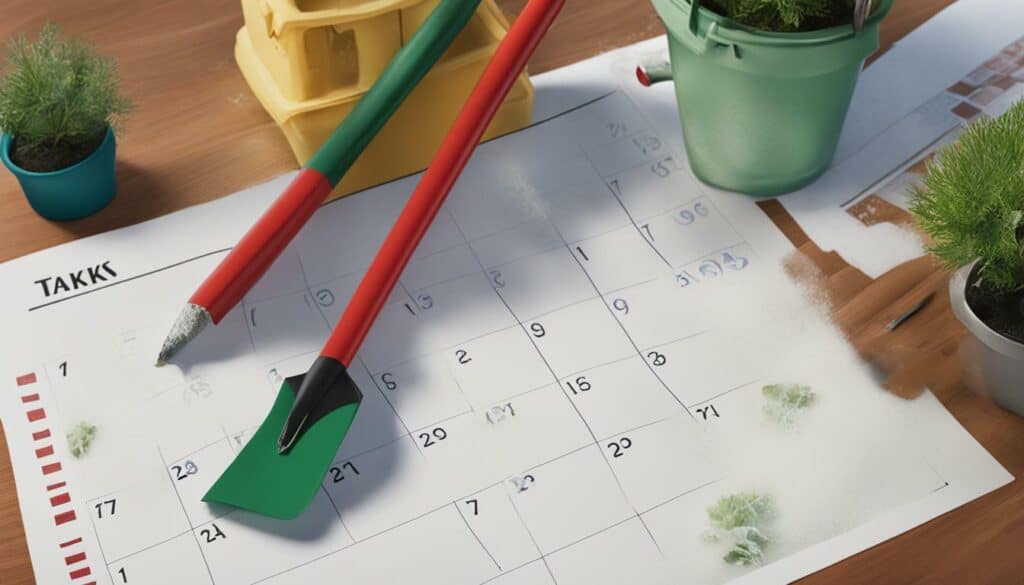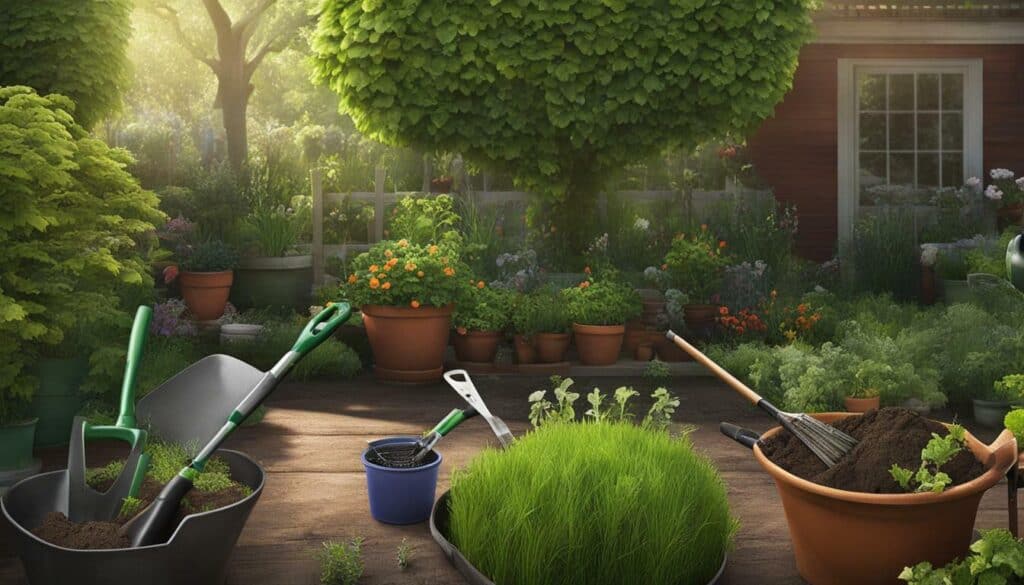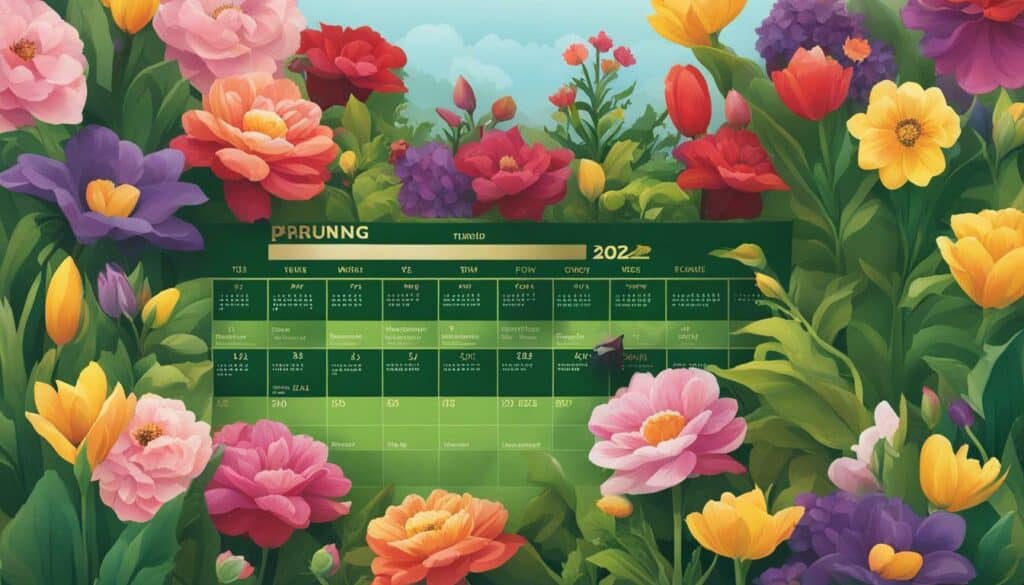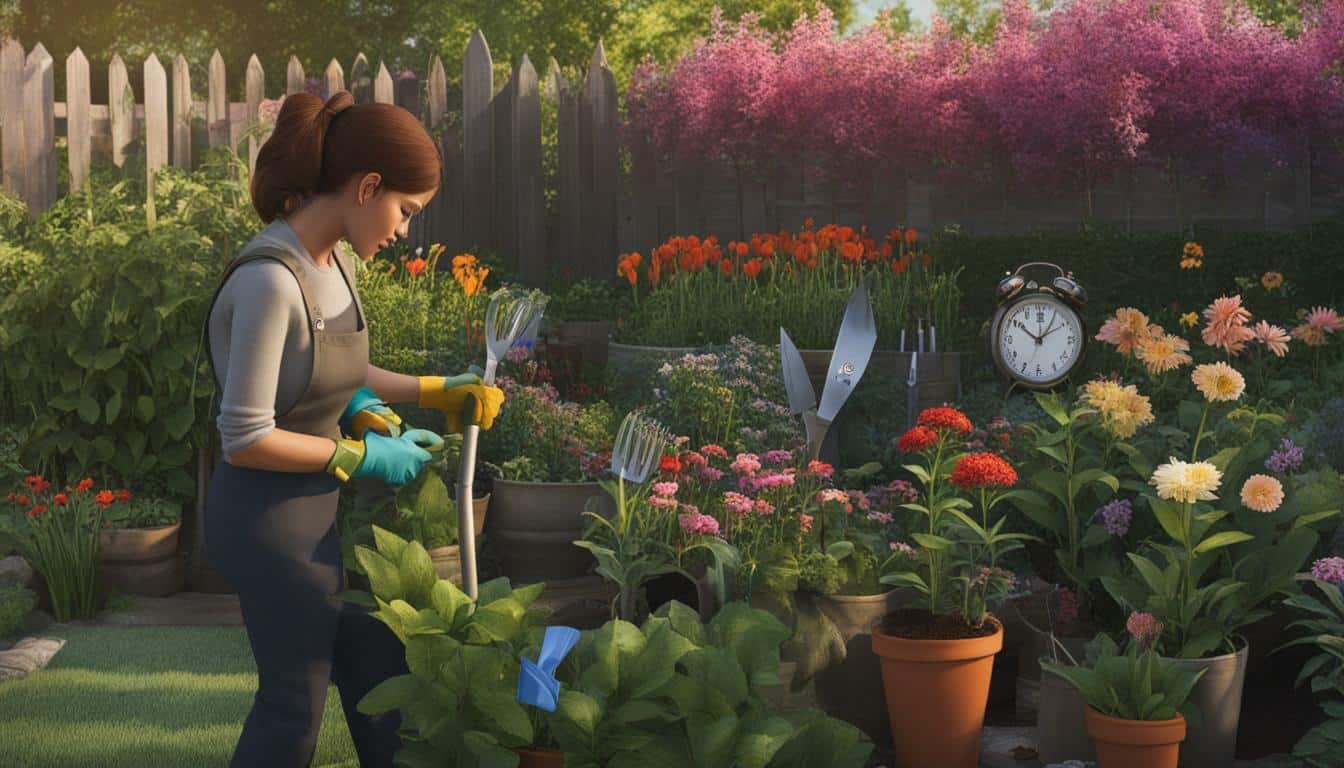Are you looking to create a maintenance gardening schedule that will keep your garden thriving throughout the year? Look no further. In this section, I will share my experience in creating a maintenance gardening schedule that has helped keep my garden flourishing all year round. By planning and organizing your gardening tasks, considering your USDA zone, local climate, and specific garden needs, you can ensure the health and productivity of your garden.
- Creating a maintenance gardening schedule involves planning and organizing tasks throughout the year.
- Consider your USDA zone, local climate, and specific garden needs when creating your schedule.
- In January, tasks include removing snow and ice from tree limbs and planning for the upcoming gardening season.
- In February, focus on cleaning and sharpening garden tools and starting seeds indoors for cool-season crops.
- In March, plant peas and potatoes, prune fruit trees, and start transplants indoors for warm-season crops.
- In April, measure rainfall, start hardening off seedlings, and remove winter protection from perennials.
- Throughout the year, maintain your garden by fertilizing, pruning, and protecting against pests.
By following a well-planned maintenance gardening schedule, you can ensure the health and productivity of your garden. Stay tuned for the upcoming sections where I will provide more detailed insights and tips for each month of the year.
Understanding Your USDA Zone and Local Climate
Before diving into your maintenance gardening schedule, it is important to understand your USDA zone and local climate. These factors play a crucial role in determining the success of your garden, as they dictate what plants will thrive in your area and when it is best to carry out specific gardening tasks.
Your USDA zone is determined by the average annual minimum temperature in your region, which helps you identify which plants are suitable for your area. By knowing your zone, you can select plants that are well-adapted to the local climate and are more likely to withstand extreme weather conditions.
Additionally, understanding your local climate allows you to plan your maintenance gardening tasks according to the seasons. Different regions experience varying frost dates, rainfall patterns, and temperature ranges throughout the year. By considering these factors, you can create a gardening to-do list that aligns with the optimal timing for planting, pruning, and general garden care.

Seasonal Gardening Tasks
To further assist you in creating an effective maintenance gardening schedule, here are some seasonal tasks to consider based on your USDA zone and local climate:
- In the spring, focus on tasks such as preparing the soil, sowing seeds, and transplanting seedlings.
- During the summer, prioritize watering and weeding, as well as keeping an eye out for pests and diseases.
- In the fall, plan for tasks like harvesting mature crops, preparing the garden for winter, and starting to plant cool-season vegetables.
- Throughout the winter, take care of indoor plants, maintain tools and equipment, and plan for the upcoming gardening season.
By incorporating these seasonal tasks into your gardening to-do list, you can ensure that your garden remains healthy and productive year-round.
| USDA Zone | Local Climate | Recommended Tasks |
|---|---|---|
| Zone 3 | Cold winters with short growing seasons | Start seeds indoors, plant hardy perennials, protect plants from frost |
| Zone 7 | Mild winters with longer growing seasons | Plant cool-season crops, start preparing soil for spring planting, prune dormant trees |
| Zone 10 | Warm winters and hot summers | Plant heat-tolerant vegetables, provide shade and adequate watering, protect plants from excessive heat |
Remember, every garden is unique, and it is essential to adapt your maintenance gardening schedule to the specific needs of your plants and the conditions in your area. By staying informed about your USDA zone and local climate, and following the recommended seasonal tasks, you can create the perfect maintenance gardening schedule that will keep your garden thriving.
Planning and Organizing Your Gardening Tasks
Now that you have a better understanding of your USDA zone and local climate, it’s time to start planning and organizing your gardening tasks. Developing a routine gardening schedule and a garden upkeep plan will help you stay on top of essential maintenance and ensure the success of your garden.
One effective way to plan your gardening tasks is by creating a monthly calendar. Start by listing the tasks that need to be done each month, taking into consideration the specific needs of your plants. This can include watering, fertilizing, pruning, and pest control. By having a clear schedule, you can prioritize and allocate your time and resources efficiently.
Another useful strategy is to break down your tasks into smaller, manageable steps. This will help you stay focused and motivated, especially if you have a large garden or limited time. For example, instead of trying to tackle all the weeding in one day, schedule a specific time each week to work on a section of your garden. By spreading out the tasks, you’ll prevent overwhelm and ensure that everything gets done.
Additionally, it’s important to make use of tools and resources to aid in your planning process. There are various gardening apps and online platforms that can help you keep track of your tasks, provide reminders, and offer valuable tips and advice. Explore these options and find the ones that best suit your needs and preferences.

Remember, creating a maintenance gardening schedule is not a one-time task. It is an ongoing process that requires flexibility and adaptation. As you gain experience and observe the needs of your garden, you may need to make adjustments to your schedule. Stay open to learning and experimenting to find the routine that works best for you and your plants.
Table: Monthly Gardening Tasks
| Month | Gardening Tasks |
|---|---|
| January | Remove snow and ice from tree limbs Clean indoor houseplants Plan for the upcoming gardening season |
| February | Clean and sharpen garden tools Order seeds Start seeds indoors for cool-season crops |
| March | Plant peas, potatoes, and parsley Prune fruit trees Start transplants indoors for warm-season crops |
| April | Measure rainfall and water the garden accordingly Start hardening off seedlings Remove winter protection from perennials |
By implementing a routine gardening schedule and a garden upkeep plan, you’ll be able to stay organized, reduce stress, and enjoy a thriving garden all year round. So grab your gardening gloves, roll up your sleeves, and get ready to create your perfect maintenance gardening schedule!
January Tasks: Preparing for the Gardening Season
As the new year begins, it’s time to kickstart your maintenance gardening schedule by tackling the tasks that will set the stage for a successful gardening season. January is an important month for preparing your garden for the upcoming year. While it may be cold outside, there are still plenty of tasks that can be accomplished to ensure your garden’s success.
One of the key tasks for January is removing snow and ice from tree limbs. Heavy snow or ice accumulation can cause branches to break, potentially damaging your trees. By carefully removing the snow and ice, you can prevent this type of damage and ensure the health and longevity of your trees.
Indoor houseplants also require attention during this month. Giving them a good cleaning helps remove dust and pests that may have accumulated over time. Wipe down the leaves with a damp cloth and inspect the plants for any signs of pest infestation. This will help keep your indoor plants healthy and vibrant.
| Annual Garden Maintenance Tasks for January: |
|---|
| Remove snow and ice from tree limbs |
| Clean indoor houseplants |
| Start planning for the upcoming gardening season |
“January is the time to lay the groundwork for a successful gardening season. By taking care of these tasks, you’ll be well-prepared for the months ahead.” – Gardening enthusiast
As you start planning for the upcoming gardening season, take some time to assess your garden’s needs and goals. Consider what worked well in the previous year and what you would like to improve upon. Create a gardening calendar or schedule to help you stay organized and on track. This will ensure you don’t miss important planting and maintenance dates throughout the year.
By following a maintenance gardening calendar and completing the necessary tasks, you’ll set yourself up for a thriving garden. With the right preparation and care, your garden will flourish with bountiful blooms and abundant harvests throughout the year.

February Tasks: Getting Ready for Cool-Season Crops
February brings the anticipation of planting cool-season crops, and your maintenance gardening schedule should reflect the tasks needed to make that happen. As winter lingers, it’s important to take advantage of the time indoors to prepare for the upcoming growing season.
Start by cleaning and sharpening your garden tools. A well-maintained set of tools will make your gardening tasks easier and more efficient. Order seeds for cool-season crops, such as lettuce, kale, and carrots. Take stock of your indoor space and start seeds indoors to give them a head start before transferring them to the garden.
Consider creating a planting schedule for your cool-season crops. This will help you stay organized and ensure a steady supply of fresh produce throughout the season. Include information such as planting dates, expected harvest times, and any specific care instructions. Keep track of your progress by using a garden maintenance checklist, which will help you stay on top of regular garden care tasks.

Incorporate these tasks into your maintenance gardening schedule for February, and you’ll be well-prepared to start planting your cool-season crops as soon as the weather permits. The careful planning and organization will pay off in the form of a bountiful and successful garden.
March Tasks: Planting and Preparing for the Warm Season
With the arrival of March, it’s time to get your hands dirty and dive into the tasks that will ensure a productive warm season in your garden. This month is all about planting and preparing your garden for the abundance of growth that lies ahead. By following a well-planned maintenance gardening schedule, you can set the stage for a beautiful and bountiful garden.
First and foremost, make sure to check your gardening calendar or create a monthly garden maintenance checklist. This will help you stay organized and ensure that you don’t miss any important tasks. Take note of the specific planting dates for your region and the recommended pruning and maintenance tasks.
When it comes to planting, March offers a variety of opportunities. Start by planting peas, potatoes, and parsley. These cool-season crops thrive in the milder temperatures of early spring. Prepare the soil by removing any weeds or debris and amend it with compost for added fertility. Follow the planting instructions for each crop and provide adequate water to support their growth.
In addition to planting, March is also the time to prune fruit trees and start transplants indoors for warm-season crops. Pruning fruit trees helps shape their growth and promotes better fruit production. Use clean and sharp tools to make clean cuts, removing any dead, damaged, or crossing branches. As for warm-season crops, start seeds indoors to get a head start on the growing season. Choose a sunny spot for your seed trays and provide them with the warmth and moisture they need to germinate.
By incorporating these tasks into your maintenance gardening schedule for March, you’ll be well on your way to a thriving garden. Remember to stay attentive to your garden’s specific needs and adapt your routine accordingly. Happy gardening!

Gardening is a labor of love, and nurturing your garden with care is essential to its overall health and productivity. As you embark on your monthly garden maintenance, be sure to prioritize watering, fertilizing, and protecting your plants.
Watering is crucial, especially as the temperatures rise and plants start to demand more moisture. Monitor the weather and adjust your watering schedule accordingly. Aim to water deeply, allowing the water to reach the roots of your plants. Consider using drip irrigation or soaker hoses to deliver water efficiently while minimizing evaporation.
Fertilizing is another key aspect of nurturing your garden. Choose a balanced organic fertilizer or compost and apply it according to the package instructions. Be mindful not to over-fertilize, as this can lead to excessive foliage growth at the expense of fruits and flowers.
Protecting your plants from pests and diseases is essential to maintaining a healthy garden. Keep an eye out for common garden pests like aphids, slugs, and snails. Implement organic pest control measures such as hand-picking, natural repellents, or introducing beneficial insects. Regularly inspect your plants for signs of disease, and promptly address any issues to prevent further spread.
By nurturing your garden with care and addressing its specific needs, you’ll be rewarded with a thriving and beautiful oasis. Keep your maintenance gardening schedule on track, and enjoy the fruits of your labor!
April Tasks: Nurturing and Preparing for Spring
As spring emerges in full swing, April brings an array of tasks that will keep your garden healthy and thriving. This is the time to give your garden the care it needs to flourish throughout the growing season. From measuring rainfall and adjusting watering to starting to harden off seedlings, there’s plenty to do to prepare your garden for the warmer months ahead.
One important task in April is to measure rainfall and water your garden accordingly. Monitoring the amount of rainfall helps you determine if your garden is getting enough water or if additional watering is necessary. Remember, different plants have varying water requirements, so it’s important to know the needs of each individual plant in your garden. By staying mindful of rainfall and watering consistently, you’ll help your plants thrive.
Another vital task is to start hardening off seedlings. If you’ve started seeds indoors, April is the perfect time to gradually acclimate them to the outdoor conditions. Hardening off is the process of exposing your seedlings to the outdoor environment gradually. This helps toughen them up and prepares them for transplanting into the garden. Begin by placing your seedlings outside for a few hours each day, gradually increasing their exposure over the course of a week. This gradual transition will help prevent shock and ensure the success of your transplants.
Additionally, April is the month to remove winter protection from perennials. As the temperature rises and the risk of frost diminishes, it’s time to uncover your dormant perennials. Remove any mulch or covers that were used to protect them during the winter months. This will allow them to receive the full benefit of the sunshine and ensure their growth and blooming in the coming season. Take the time to inspect your perennials for any winter damage and trim off any dead or damaged foliage to promote healthy growth.

| Task | Description |
|---|---|
| Measure rainfall | Monitor rainfall to determine if additional watering is necessary. |
| Start hardening off seedlings | Gradually expose seedlings to outdoor conditions for successful transplanting. |
| Remove winter protection from perennials | Uncover dormant perennials and inspect for damage. Trim off any dead or damaged foliage. |
By incorporating these tasks into your maintenance gardening schedule for April, you’ll ensure that your garden is well-prepared for the spring season. With proper care and attention, your plants will thrive and reward you with a beautiful and bountiful garden.
Year-Round Maintenance: Fertilizing, Pruning, and Protecting
Maintaining your garden’s health and productivity requires year-round care and attention, and this section will guide you through the essential maintenance tasks that should be part of your gardening schedule. By incorporating regular garden care into your routine, you can ensure that your plants thrive and your garden remains a beautiful oasis throughout the seasons.
Fertilizing:
Fertilizing is a key aspect of garden maintenance, as it provides essential nutrients that promote growth and overall plant health. A garden maintenance checklist should include regular fertilizing to replenish soil nutrients and support robust plant growth. The frequency and type of fertilizer will depend on the specific needs of your garden and the plants you are growing.
When fertilizing, it’s important to follow the instructions provided by the manufacturer, as over-fertilization can harm plants. Consider performing a soil test to determine the specific nutrient deficiencies in your garden, which can help you choose the right fertilizer and application rates. Remember to water your plants after fertilizing to ensure that the nutrients are absorbed by the roots.
Pruning:
Pruning plays a crucial role in shaping and maintaining the overall structure of your garden. It helps promote healthy growth, improves air circulation, and enhances the aesthetic appeal of your plants. When pruning, use sharp and clean pruning tools to prevent the spread of diseases. Regularly inspect your plants for dead or damaged branches, and remove them promptly to prevent potential hazards and disease outbreaks.
Pruning can also help control the size of your plants and encourage the development of more flowers or fruits. Refer to a garden maintenance calendar to identify the appropriate time to prune specific plants, as some may require pruning in early spring, while others may benefit from pruning in late winter or early fall.
Protecting:
Protecting your garden from pests, diseases, and harsh weather conditions is essential for its long-term success. Regularly inspect your plants for signs of pests or diseases, such as yellowing leaves, wilting, or unusual spots. Implement preventive measures, such as applying organic insecticides and fungicides, to prevent infestations and keep your plants healthy.
During extreme weather conditions, consider providing protection to vulnerable plants. For example, you can cover delicate plants with frost cloth to prevent damage from frost or provide shade to plants during scorching summer days. Keeping an eye on weather forecasts and adjusting your garden care routine accordingly will help protect your plants from unnecessary stress and damage.

Summary:
In summary, regular garden care is crucial for maintaining the health and productivity of your garden. Fertilizing, pruning, and protecting against pests and harsh weather conditions are essential tasks that should be part of your maintenance gardening schedule. By following a well-planned routine and incorporating these tasks into your regular gardening activities, you can create a thriving and beautiful garden that brings joy and satisfaction all year round.
| Maintenance Tasks | Frequency |
|---|---|
| Fertilizing | Monthly or as needed |
| Pruning | As required (refer to plant-specific guidelines) |
| Protecting against pests and diseases | Regular monitoring and immediate action as needed |
Conclusion on Creating Your Perfect Maintenance Gardening Schedule
Congratulations on completing your journey in creating an optimal maintenance gardening schedule that will set your garden up for success!
Throughout this article, we have explored the importance of planning and organizing your gardening tasks. By considering your USDA zone, local climate, and specific garden needs, you have taken the necessary steps to ensure the health and productivity of your garden.
In January, it’s crucial to remove snow and ice from tree limbs, give indoor houseplants a cleaning, and start planning for the upcoming gardening season. In February, clean and sharpen garden tools, order seeds, and start seeds indoors for cool-season crops. March is all about planting peas, potatoes, and parsley, pruning fruit trees, and starting transplants indoors for warm-season crops. And in April, be sure to measure rainfall and water the garden accordingly, start hardening off seedlings, and remove winter protection from perennials.
Remember, maintenance and care for your garden is a year-round commitment. Fertilizing, pruning, and protecting against pests are tasks that should be consistently included in your maintenance gardening schedule. By adhering to a well-planned routine, you can guarantee that your garden thrives and flourishes.
So, go ahead and put your maintenance gardening schedule into action. Enjoy the beauty and abundance that your garden will bring, thanks to your dedication and thoughtful planning. Happy gardening!
FAQ on Creating Your Perfect Maintenance Gardening Schedule
Q: What is a maintenance gardening schedule?
A: A maintenance gardening schedule is a plan that outlines the tasks and activities needed to keep your garden healthy and thriving throughout the year. It helps you stay organized and ensures that you are addressing the specific needs of your garden.
Q: How do I create a maintenance gardening schedule?
A: To create a maintenance gardening schedule, consider your USDA zone, local climate, and the specific needs of your garden. Plan and organize your tasks according to the seasons, such as pruning in the winter and planting in the spring. Regularly maintain and care for your garden, including fertilizing, pruning, and protecting against pests.
Q: Why is understanding my USDA zone and local climate important for my gardening schedule?
A: Understanding your USDA zone and local climate helps you determine the appropriate timing for specific gardening tasks. Different plants thrive in different climate conditions, and knowing your zone will guide you in choosing the right plants and planning your tasks accordingly.
Q: What should I include in my gardening tasks for January?
A: In January, tasks in your maintenance gardening schedule may include removing snow and ice from tree limbs, giving indoor houseplants a cleaning, and starting to plan for the upcoming gardening season.
Q: What gardening tasks should I focus on in February?
A: In February, prioritize tasks such as cleaning and sharpening garden tools, ordering seeds, and starting seeds indoors for cool-season crops.
Q: What should I plant and prepare for in March?
A: In March, plant peas, potatoes, and parsley, prune fruit trees, and start transplants indoors for warm-season crops.
Q: What are some important tasks for April?
A: In April, measure rainfall and water the garden accordingly, start hardening off seedlings, and remove winter protection from perennials.
Q: What maintenance tasks should I perform throughout the year?
A: Throughout the year, it is important to maintain and care for your garden by fertilizing, pruning, and protecting against pests. Regularly check the health of your plants and address any issues that arise.
Q: How can a well-planned maintenance gardening schedule benefit my garden?
A: A well-planned maintenance gardening schedule ensures that your garden’s needs are met consistently. It helps promote healthy growth, prevents problems before they escalate, and maximizes the productivity and beauty of your garden.





Leave a Reply